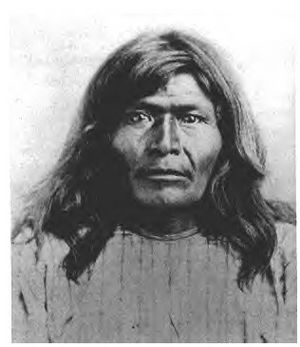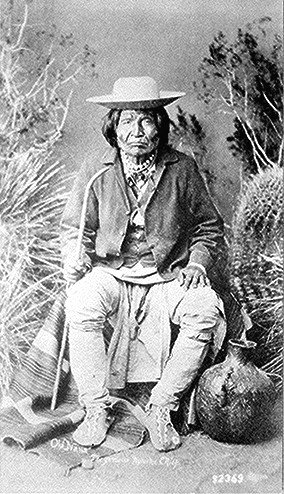Battle of Tres Castillos facts for kids
The Battle of Tres Castillos took place on October 14–15, 1880. It happened in Chihuahua State, Mexico. This battle was a major event because it resulted in the death of Victorio. He was a famous Chiricahua Apache leader. Most of his followers were also killed or captured. The battle ended Victorio's War. This war was a 14-month journey of fighting and moving by the Apaches. It covered southern New Mexico, western Texas, and Chihuahua. Mexican Colonel Joaquin Terrazas and his 260 men surrounded the Apache group. They killed 62 men, including Victorio. They also killed 16 women and children. Another 68 women and children were captured. Only three Mexican soldiers died. Victorio's group had very little ammunition to fight back.
Why the Battle Happened
In 1879, Victorio was a respected Chiricahua war chief. His people were being forced to leave their home. This home was a reservation called Ojo Caliente in New Mexico. They were told to move to the San Carlos Apache Indian Reservation in Arizona. On August 21, 1879, Victorio and about 80 warriors left the reservation. Their families went with them. Other Apache groups joined Victorio, especially the Mescalero people. His fighting group may have grown to 200 warriors. This was a very large number of Apache fighters for one leader.
For 14 months, Victorio led a guerrilla war. This meant he used surprise attacks and quick movements. He fought against the U.S. and Mexican armies. He also fought against settlers in southern New Mexico, western Texas, and northern Mexico. He fought in many battles and small fights. He also raided several towns. Thousands of American and Mexican soldiers chased him. They had many Native American scouts helping them. Victorio often won these fights. But the number of soldiers and resources against him became too much.
Victorio had a big problem: he needed ammunition. To get it, he had to trade stolen cattle and horses. Sometimes he stole ammunition directly. One place he got supplies was the Mescalero Apache Reservation. But after a battle in April 1880, the U.S. army took control of that reservation. This made it harder for Victorio to get what he needed.
In May 1880, Victorio lost a battle for the first time. This defeat was by other Apaches in New Mexico. He then led his group into Mexico to rest. He gathered many animals there. In July, he went to west Texas. He tried to take the animals to the Mescalero Reservation. He hoped to trade them for ammunition. But in Texas, he met Colonel Benjamin Grierson. Grierson was a commander of the 10th Cavalry. These were African-American soldiers. Grierson used a new plan. Instead of chasing Victorio, he guarded important places. These included water springs, river crossings, and mountain passes. His plan was to stop Victorio from reaching New Mexico. This would cut off his ammunition supply. It would also prevent him from getting water in the desert. Grierson also worked with Mexican troops. They crossed the Rio Grande River to help hunt Victorio. Grierson did not defeat Victorio in battle. But he stopped him from getting to New Mexico and getting more ammunition.
Victorio went back to Mexico around August 13, 1880. His luck was running out. Some of his supporters left him. The fighting and hardships were too much for them.
Finding Victorio's Hideout
Victorio usually chose mountain hideouts. But this time, he picked a quiet desert plain. It had a small lake and three piles of rocks. These rocks were called Tres Castillos, meaning "Three Castles." He told his followers that his enemies would look for him in the mountains. They would not expect him in the desert. He sent his helper, Nana, and a few men to find ammunition. Victorio and his smaller group found some peace in the quiet Chihuahua Desert. They reached Tres Castillos in early October. Meanwhile, Mexican and American soldiers searched northern Mexico for him.
By September 29, Colonel Joaquin Terrazas had gathered his forces. He was the commander of Mexican forces in Chihuahua. He had 350 men, some soldiers and some volunteers. They were at Tres Patos Lake. This lake was about 200 miles northwest of Tres Castillos. On October 1, his group split up. They spread out across the desert, moving east. Terrazas found a muddy pond. There was freshly killed livestock nearby. This showed that Victorio's group had passed that way. On October 8, one of his Tarahumara scouts reported something. Victorio might be near Tres Castillos, about 70 miles away. Terrazas sent away 90 "worthless civilians" from his group. He marched south with 260 men. He also refused help from an American group. This group had 13 Texas Rangers. Terrazas told them to go back to the U.S. On October 13, Terrazas found fresh tracks. These tracks showed Victorio was at Tres Castillos. American troops from the 10th Cavalry had entered Mexico in early October. They worked with the Chihuahua state army. But when Victorio was found, Colonel Terrazas asked the American troops to leave.
Tres Castillos means "Three Castles." It has three low, rocky hills. They rise less than 100 feet above a wide plain. They are easy to spot in the area. In October, the rainy season ends. The temporary lakes and streams nearby had water. So Tres Castillos was like an oasis. As Terrazas got closer, he sent his second-in-command, Juan Mata Ortiz, to go around Tres Castillos from the north. Terrazas himself went around from the south.
The Battle Begins
The Apaches saw Terrazas coming when he was still about 1,000 yards away. They sent out 30 warriors to stop him. They killed a Tarahumara scout. But they quickly went back to the rocky hills. They saw how many soldiers were coming. Terrazas and Mata Ortiz captured the Apache's horses. This forced the Apaches to retreat to the southernmost of the Tres Castillos hills. Around 10 p.m. that night, Terrazas saw a fire to his south. He sent a group of 30 men to check it out. Some Apaches who were not trapped on Tres Castillos had set the fire. They wanted to draw the Mexicans away. After a short fight with the Mexican patrol, these Apaches ran away. They likely escaped the area.
Victorio and his followers kept fighting the Mexicans all night. They built rock defenses and hid in caves. Terrazas said the fighting was desperate as the Mexicans moved forward. But the Apaches probably ran out of ammunition quickly. The last two warriors held out in a cave for two hours. They were killed at 10:00 a.m. Only one rifle cartridge was found in the cave. This shows they could barely defend themselves.
Three Mexican soldiers died in the battle. Terrazas reported that he killed 62 warriors. Some of these were probably boys. He also killed 16 women and children. He took 68 prisoners. The surviving women and children were taken by the Mexican forces. Some Apaches say that Victorio was killed by a Tarahumara sharpshooter. The Apache survivors were mostly men who were not there. Nana was on a raid with 17 men. Another 15 men were on a different raid. A few Mescalero people were hunting and were not at Tres Castillos. A small number of women and children also managed to escape.
What Happened Next
Historian Dan L. Thrapp called Tres Castillos a "massacre" instead of a battle. This was because the Apaches had so little ammunition. Victorio's followers who were not at the battle, like Nana, quickly sought revenge. Nine Mexican soldiers were killed in a surprise attack. Nana led the survivors to a safe place in the Sierra Madre Occidental mountains. In 1881, he led a long and successful raid into the United States.
The city of Chihuahua celebrated Terrazas, Mata Ortiz, and Mauricio Corredor. Corredor was the Tarahumara who was said to have killed Victorio. The townspeople held a parade to show off the captured Apaches. The Apache children were taken to live with families in Chihuahua.
Juan Mata Ortiz, the Mexican second-in-command at Tres Castillos, was killed by Geronimo in a surprise attack on November 13, 1882. Mauricio Corredor, the Tarahumara sharpshooter, was killed in 1886. This happened during a fight between American and Mexican forces. A famous American scout named Emmet Crawford also died in that fight. Colonel Terrazas died peacefully in his bed in 1901. A monument honoring him and his victory at Tres Castillos was built in Chihuahua City in 1910.
The Battle of Tres Castillos marked the end of large-scale conflicts. These were fights between Apache groups and American and Mexican forces. After Victorio's death, Apache fighters never again gathered in such large numbers. They also never again had such a skilled leader. Raids and conflicts by Apaches after Victorio were smaller. They were not as big as Victorio's force or the damage it caused.
|





